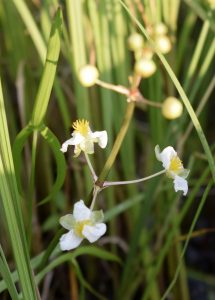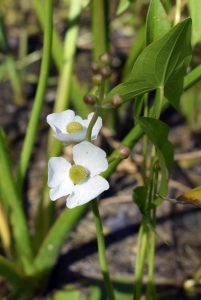Broad-leaf Arrowhead

Sagittaria latifolia arrives in early summer with distinctive, arrowhead-shaped leaves emerging from the shallow waters of swamps, streams and wet ditches. Accordingly, July through September, male and female flowers appear on a spike-like raceme up to 12″ long on 1″ stalks coming out from the stem in whorls of three. Usually the male flowers are above the females on the stem. Sometimes the stem has a single gender only, and sometimes there are perfect flowers with both genders. Female flowers have a big fuzzy center, somewhat bulbous and covered with tiny carpels (the female organs). Male flowers accompanying her are distinguishable by a differentiated cluster of golden yellow stamens in their centers.
I grew up admiring arrowhead flowers from the side of our canoe whilst exploring Little Bass Lake’s swamps and shallow bays. The pure white petals of these flowers shine out from a backdrop of cattails and swamp grasses — as if designed to catch attention. Otherwise known as duck potato, the tubers of this plant can be dug out in late summer at about the time the leaves die back. Roast these like a potato, then remove the skin and enjoy. Tribal nations also traditionally grind the dried tubers into flour.
While Minnesota has several species of Sagittaria, broad-leaf arrowhead has the largest leaves at 8″ to 16″ long. Another way to tell them apart is by the size and shape of the bracts located at the base of each flower whorl. Broad-leaf arrowhead has little rowboat-shaped bracts. Note the thin leaves in the photo of the male flowers compared with the broader leaves in the photo of female flowers. This variability occurs in the leaves based on moisture conditions. When the plant is growing in deeper water among the reeds and rushes a bit out from shore and basically only approachable by canoe (my favorite way to find them), the leaves present much slimmer. Many other flowers bloom in the same habitat as Sagittaria, such as marsh skullcap.

Note that this is not the ‘arrowroot’ found in stores used as a thickener; that white, powdered starch comes from tropical plants of a completely different family, genus and species.
